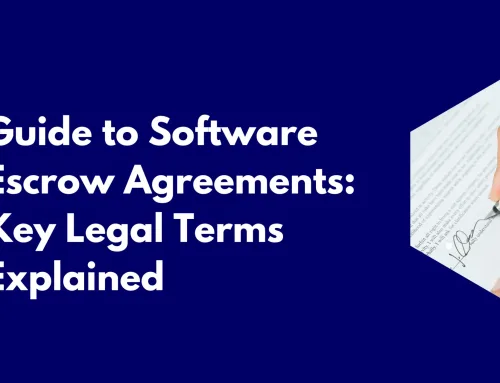What are the Release Events and Clauses in Software Escrow Agreements?
Software escrow agreements are instrumental in mitigating risks associated with software development and deployment. These agreements involve a third-party software escrow company storing the source code, documentation and other critical assets in a secure cloud environment. Release events and clauses within these software escrow agreements play a pivotal role in defining the conditions under which the deposited source code and other materials can be released. In this blog post, we will look into release events and clauses, exploring their significance and how they contribute to the overall effectiveness of software escrow arrangements.
Understanding Software Escrow
Before we examine release events and clauses, it’s essential to understand the basics of software escrow. A typical software escrow agreement involves a three party arrangement between a software developer (the depositor), the end user (beneficiary) and the software escrow company. The software developer deposits the source code and related materials with the software escrow company. The objective of a software escrow agreement is to provide comfort to the beneficiary that if the software developer is unable or unwilling to support the software, the source code and other critical components such as databases, deployment scripts and documentation can be released to them.
Release Events: Triggers for a Software Escrow Release
Release events are specific conditions or triggers defined in the software escrow agreement that allow the beneficiary to access and use the source code and other deposited materials. These release conditions for a software escrow agreement usually include:
- Bankruptcy or Insolvency: If the software developer goes bankrupt or becomes insolvent, the source code and other materials may be released to the beneficiary. This ensures that the beneficiary can continue using and maintaining the software even if the developer faces financial challenges, enabling business continuity.
- Discontinuing Support: In the event of the software developer discontinuing support for the software, the source code and other materials can be released. This safeguards the beneficiary against the sudden abandonment of the software by the developer.
- Failure to Maintain or Update: If the software developer fails to fulfil its contractual obligations regarding software maintenance or updates, the source code and other materials can be released. This ensures that the beneficiary can access the latest version of the software and address any potential vulnerabilities or issues.
- Transfer of IP rights to a third party: There could be a situation where the original software developer grants or transfers some or all of their IP rights to another entity. This transfer could occur due to reasons such as mergers, acquisitions or strategic partnerships. The transfer of IP rights could result in the beneficiary not receiving the same level of protection provided in the software escrow agreement which could introduce uncertainties and risks for the beneficiary, resulting in the source code and other materials to be released to them.
Below is an extract of the standard release events included within an Escrow London software escrow agreement:
- Depositor’s material failure to support the Product in accordance with the License Agreement and failed to cure such material failure within ten (10) Business Days of Beneficiary’s written notice to Depositor of such material failure;
- Depositor becomes unable to pay its debts or is deemed to be unable to pay its debts;
- of a trustee, receiver or other custodian for Depositor, or makes a general assignment for the benefit of its creditors;
- Any bankruptcy, reorganisation, debt arrangement, or other case or proceeding under any bankruptcy or insolvency law, or any dissolution or liquidation proceedings commenced by or against Depositor, and if such case or proceeding is not commenced by Depositor if it is acquiesced in or remains un-dismissed for sixty (60) days;
- Depositor ceases active operation of its business or discontinues the licensing or maintenance of the Deposit Materials in material breach of the License Agreement; or
- Depositor assigns its Intellectual Property rights to the Product to a “Third Party” and within sixty (60) days, the Third Party does not agree to offer the Beneficiary substantially similar protection to that provided by this Agreement without significantly increasing the cost to the Beneficiary.
Software Escrow Clauses: Defining Terms and Conditions
Software escrow release clauses are the detailed terms and conditions specified in the software escrow agreement. These clauses provide a framework for how the escrowed materials will be handled and released. Key components of software escrow clauses include:
- Verification Process: The agreement may outline a verification process to ensure that the deposited materials are complete, up-to-date and usable. This process may involve regular audits or inspections by the software escrow company.
- Software Escrow Fees: The agreement should clearly state the fees associated with software escrow services. This may include initial setup fees, ongoing maintenance fees and release fees. Understanding these costs is crucial for all parties involved.
- Confidentiality and Use Restrictions: Clauses may specify confidentiality obligations, restricting the use of the deposited source code and other materials to the beneficiary’s internal purposes and preventing unauthorised distribution.
- Dispute Resolution: In case of disagreements or disputes between the parties, the software escrow agreement should outline a dispute resolution, such as an appointment of an independent arbitrator, to decide whether or not an event of default has occurred at the time the release application was delivered.
Detailed information on Software Escrow Clauses as well as downloadable software escrow agreement templates can be found here.
Conclusion
By clearly defining release events and outlining detailed software escrow clauses, these agreements enhance trust between software developers and beneficiaries, offering risk mitigation in case of unforeseen circumstances. As businesses increasingly rely on software and software as a service (SaaS) solutions, understanding and incorporating these elements into software escrow agreements becomes paramount for effective risk management and business continuity.
To view a detailed video on the typical release events within a software escrow agreement, please click here.
##
About Escrow London
Escrow London is a global software and SaaS escrow company with offices in London, UK, and Sydney, Australia. Our North American division called The Escrow Company, is based in Atlanta, US.
We have invested considerable resources into innovation to reinvent software escrow for a SaaS world. Escrow London provides a range of SaaS continuity escrow solutions suitable for AWS, Microsoft Azure and Google Cloud hosted SaaS applications. We support a wide range of clients includes major law firms, banks, central banks, insurance companies, technology companies and government organisations.
To find out more about Escrow London and our software escrow and SaaS continuity escrow solutions, visit our YouTube channel.








